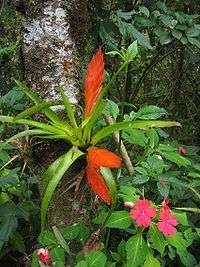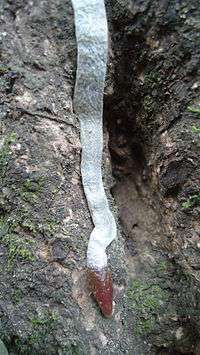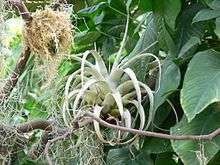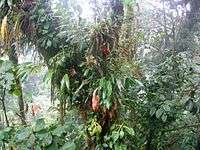Epiphyte


An epiphyte is a plant that grows harmlessly upon another plant (such as a tree) and derives its moisture and nutrients from the air, rain, and sometimes from debris accumulating around it. Epiphytes differ from parasites in that epiphytes grow on other plants for physical support and do not necessarily negatively affect the host. An epiphytic organism that is not a plant is called an epibiont.[1] Epiphytes are usually found in the temperate zone (e.g., many mosses, liverworts, lichens, and algae) or in the tropics (e.g., many ferns, cacti, orchids, and bromeliads).[2] Many houseplants are epiphyte species due to their minimal water and soil requirements. Epiphytes provide a rich and diverse habitat for other organisms including animals, fungi, bacteria, and myxomycetes.[3]
Epiphyte is one of the subdivisions of the Raunkiær system.

The term epiphytic derives from the Greek epi- (meaning 'upon') and phyton (meaning 'plant'). Epiphytic plants are sometimes called "air plants" because they do not root in soil. However, there are many aquatic species of algae, including seaweeds, that are epiphytes on other aquatic plants (seaweeds or aquatic angiosperms).
Biodiversity
The best-known epiphytic plants include mosses, orchids, and bromeliads such as Spanish moss (of the genus Tillandsia), but epiphytes may be found in every major group of the plant kingdom. 89% of epiphyte species (about 24,000) are flowering plants. The second largest group are the leptosporangiate ferns, with about 2800 species (10% of epiphytes). In fact, about one third of all ferns are epiphytes.[4] The third largest group is clubmosses, with 190 species, followed by a handful of species in each of the spikemosses, other ferns, Gnetales, and cycads.[5]
Physiognomy

Epiphytic organisms usually derive only physical support and not nutrition from their host, though they may sometimes damage the host. Parasitic and semiparasitic plants growing on other plants (mistletoe is well known) are not "true" epiphytes (a designation usually given to fully autotrophic epiphytes), but are still epiphytic in habit. Plants such as New Zealand species of Griselinia – which send long roots down towards the soil while fixed high in another plant and reliant upon it for physical support – are also epiphytic in habit.
Some epiphytic plants are large trees that begin their lives high in the forest canopy. Over decades they send roots down the trunk of a host tree eventually overpowering and replacing it. The strangler fig and the northern rātā (Metrosideros robusta) of New Zealand are examples of this. Epiphytes that end up as free standing trees are also called hemiepiphytes.
Nutrition
Epiphytic plants use photosynthesis for energy and (where non-aquatic) obtain moisture from the air or from dampness (rain and cloud moisture) on the surface of their hosts. Roots may develop primarily for attachment, and specialized structures (for example, cups and scales) may be used to collect or hold moisture.
Ecology
The first important monograph on epiphytic plant ecology was written by A.F.W. Schimper (Die epiphytische Vegetation Amerikas, 1888). Assemblages of large epiphytes occur most abundantly in moist tropical forests, but mosses and lichens occur as epiphytes in almost all biomes. In Europe there are no dedicated epiphytic plants using roots, but rich assemblages of mosses and lichens grow on trees in damp areas (mainly the western coastal fringe), and the common polypody fern grows epiphytically along branches. Rarely, grass, small bushes or small trees may grow in suspended soils up trees (typically in a rot-hole).
Epiphytic plants attached to their hosts high in the canopy have an advantage over herbs restricted to the ground where there is less light and herbivores may be more active. Epiphytic plants are also important to certain animals that may live in their water reservoirs, such as some types of frogs and arthropods.
Epiphytes can have a significant effect on the microenvironment of their host, and of ecosystems where they are abundant, as they hold water in the canopy and decrease water input to the soil.[6] The epiphytes create a significantly cooler and moister environment in the host plant canopy, potentially greatly reducing water loss by the host through transpiration.
See also
- Epiphyllum - a genus of epiphytic cacti
- Parasitic plant
- Epilith, an organism that grows in a rock
- Epibiont, an organism that grows on another life form
- Epiphytic bacteria
References
- ↑ Hickey, M.; King, C. (2001). The Cambridge Illustrated Glossary of Botanical Terms. Cambridge University Press.
- ↑ Webster's Third New International Dictionary of the English Language, Unabridged. (1976). Vol. I, p. 764. Encyclopædia Britannica, Inc. Chicago.
- ↑ Sydney E. Everhart, Joseph S. Ely, and Harold W. Keller (2009). "Evaluation of tree canopy epiphytes and bark characteristics associated with the presence of corticolous myxomycetes" (PDF). Botany 87: 509–517. doi:10.1139/b09-027.
- ↑ Hogan, C Michael, 2010. Fern. Encyclopedia of Earth. National council for Science and the Environment. Washington, DC
- ↑ Schuettpelz, Eric (2007), The evolution and diversification of epiphytic ferns (PDF), Duke University PhD thesis
- ↑ Stanton, D.E., Chávez, J.H., Villegas, L., Villasante, F., Armesto, J., Hedin, L.O., Horn, H. "Epiphytes Improve Host Plant Water Use by Microenvironment Modification", Functional Ecology (journal), doi: 10.1111/1365-2435.12249
External links
| Wikimedia Commons has media related to Epiphytes. |